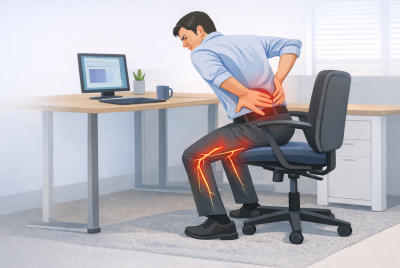Unbearable Sciatica Pain
Discover relief from unbearable sciatica pain with our comprehensive guide, which offers insights and tips. Say goodbye to sciatica pain now! Living with unbearable sciatica pain is a challenging journey that many individuals navigate. As an enthusiast and advisor on sciatica, I understand the profound impact it can have on daily life. In this personal guide to relief, we will delve deeper into the causes, symptoms, and effective strategies to manage and alleviate this persistent discomfort.
Causes of Sciatica Pain
Herniated Discs
Herniated discs, often a result of wear and tear on the spine, can exert prolonged pressure on the sciatic nerve, leading to not only sharp pain but also long-term discomfort and reduced quality of life.
Spinal Stenosis
The narrowing of the spinal canal, known as spinal stenosis, is a common culprit behind sciatica. This constriction puts persistent pressure on the nerve roots, triggering not only pain but also limiting mobility.
Piriformis Syndrome
The piriformis muscle, located in the buttocks, can become a source of irritation for the sciatic nerve when it tightens or spasms. This often-overlooked syndrome can cause radiating pain that is both debilitating and challenging to manage.
Symptoms of Unbearable Sciatica Pain
Sharp Shooting Pain
The hallmark of sciatica is a sharp, shooting pain that originates in the lower back and radiates down the leg. This excruciating pain can be persistent, making even simple daily tasks seem insurmountable.
Numbness and Tingling
Accompanying the pain are sensations of numbness and tingling, referred to as paresthesia. These sensations, while not always constant, contribute to the overall discomfort experienced by individuals with sciatica.
Muscle Weakness
Long-term sciatica can lead to muscle weakness in the affected leg. This weakness not only impacts mobility but also hinders individuals in their pursuit of an active and fulfilling life.
Diagnosing Sciatica
A proper diagnosis is the first step towards effective management.
Physical Examination
Physicians conduct a thorough physical examination, assessing reflexes, muscle strength, and range of motion. Understanding the physical manifestations is crucial in developing a targeted treatment plan.
Imaging Tests
Diagnostic tools such as MRI or X-rays play a vital role in visualizing the spine and pinpointing issues like herniated discs or spinal stenosis. These tests provide a comprehensive view that aids in accurate diagnosis and subsequent treatment.
Self-Care Tips for Managing Sciatica
Hot and Cold Therapy
Beyond just alleviating pain, the use of hot and cold therapy can effectively reduce inflammation, providing a dual-action approach to managing sciatica discomfort.
Gentle Stretching Exercises
Incorporating a variety of gentle stretching exercises into the daily routine can enhance flexibility and alleviate the tension that exacerbates sciatica symptoms.
Maintaining Good Posture
Proper posture is not only a preventive measure but also a key element in managing sciatica pain. Consistently maintaining good posture reduces the strain on the lower back, contributing to long-term relief.
Medical Treatments for Sciatica
Pain Medications
Over-the-counter or prescription medications play a crucial role in managing acute sciatica pain. These medications not only provide relief but also contribute to improved functionality during the recovery process.
Physical Therapy
A structured physical therapy program, guided by a professional, can address specific weaknesses and imbalances, promoting muscle strength and overall spine health.
Injections
For targeted relief, corticosteroid injections directly into the affected area can significantly reduce inflammation, providing respite from sciatica pain.
Alternative Therapies
Chiropractic Care
Chiropractic adjustments aim to realign the spine, alleviating pressure on the sciatic nerve. Many individuals find relief through this alternative approach to managing sciatica.
Acupuncture
The ancient practice of acupuncture, involving the insertion of thin needles, stimulates nerves and may reduce pain signals. While individual responses vary, acupuncture has gained recognition as a complementary therapy for sciatica.
Lifestyle Changes to Alleviate Sciatica Pain
Exercise Routine
Regular, low-impact exercises, such as swimming or walking, contribute not only to overall health but also support the spine’s resilience against sciatica pain.
Healthy Diet
A nutrient-rich diet plays a significant role in tissue repair and inflammation reduction, fostering an environment conducive to sciatica pain management.
Adequate Sleep
Quality sleep is a critical component of the healing process. It aids in pain management and overall well-being, contributing to a more balanced and healthier lifestyle.
Ergonomics and Sciatica
Proper Sitting Habits
Ergonomics extends beyond the workplace. Maintaining a neutral spine position while sitting in any environment prevents unnecessary strain on the lower back, reducing the risk of sciatica flare-ups.
Supportive Furniture
Investing in ergonomic chairs and mattresses provides the necessary support for a healthy spine. Making these changes can contribute significantly to long-term sciatica management.
Preventing the Recurrence of Sciatica
Regular Exercise
Consistent physical activity is not only beneficial for acute pain relief but also strengthens muscles, reducing the likelihood of sciatica recurrence.
Body Mechanics Awareness
Being mindful of body mechanics in daily activities prevents unnecessary strain on the lower back, acting as a proactive measure against sciatica recurrence.
Coping Strategies for Unbearable Sciatica Pain
Mindfulness and Relaxation Techniques
Incorporating mindfulness and relaxation exercises into daily life can significantly contribute to stress management and pain alleviation associated with sciatica.
Support Groups
Joining support groups provides individuals with a platform to share experiences, coping strategies, and emotional support. Building a sense of community is instrumental in navigating the challenges of unbearable sciatica pain.
When to Seek Professional Help
Persistent Pain
If sciatica pain persists despite self-care efforts, seeking professional medical help is not just advisable but imperative for a comprehensive evaluation and targeted treatment plan.
Progressive Symptoms
Any worsening symptoms or the development of new issues should prompt immediate medical attention. Identifying and addressing changes in symptoms early on can prevent further complications.
Common Mistakes in Managing Sciatica
Ignoring Warning Signs
Neglecting early symptoms can lead to prolonged and more severe sciatica. Addressing warning signs promptly is crucial for effective management.
Overreliance on Pain Medication
While pain medication can provide temporary relief, overreliance without addressing the root cause hinders long-term management. A holistic approach ensures a more sustainable and comprehensive solution.
Personal Success Stories
Real-life experiences serve as powerful examples of resilience and successful management of sciatica. Understanding the journeys of others, their challenges, and the lessons they’ve learned can inspire and provide valuable insights.
FAQs – Unbearable Sciatica Pain
How can I prevent sciatica pain from recurring?
Regular exercise, maintaining proper posture, and being mindful of body mechanics can significantly reduce the risk of sciatica recurrence. Incorporating these practices into daily life is essential for long-term relief.
Are alternative therapies like acupuncture effective for sciatica?
While individual responses vary, many people find relief through alternative therapies such as acupuncture. It’s essential to consult with a healthcare professional before trying any new treatment to ensure its suitability for individual needs.
Can overreliance on pain medication be harmful in managing sciatica?
Overreliance on pain medication without addressing the underlying cause can be counterproductive. It’s crucial to explore a holistic approach, including lifestyle changes and therapeutic interventions, to manage sciatica effectively and avoid potential side effects of prolonged medication use.
When should I seek professional help for unbearable sciatica pain?
If the pain persists despite self-care efforts or if there are progressive symptoms, seeking professional medical help is advisable. Timely intervention can lead to a more accurate diagnosis and tailored treatment plan.
How important is a healthy diet in managing sciatica?
A healthy diet rich in nutrients plays a crucial role in tissue repair and reducing inflammation, supporting overall well-being and aiding in the management of sciatica pain. It is an integral part of a comprehensive approach to long-term sciatica management.
Unbearable Sciatica Pain – Conclusion
Effectively managing unbearable sciatica pain requires a multifaceted approach. By gaining an in-depth understanding of the causes and symptoms and implementing proactive measures, individuals can regain control of their lives. Whether through self-care, medical interventions, or lifestyle adjustments, finding a personalized strategy is key to breaking free from the shackles of sciatica pain.
Disclaimer
Please note that the information provided in this article is for informational purposes only and should not replace professional medical advice. If you’re experiencing sciatica pain or any health concerns, it’s advisable to consult a healthcare professional for proper diagnosis and treatment.






